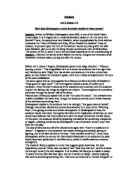Euphemism is used in Lady Macbeth’s speech as she does not want to emphasise the murder and only refers to the deed as ‘it.’ Uncertainty and fear is shown by this as Lady Macbeth cannot face up to the full consequences of the immense crime she is involved in. A whispered tone is about these words of hers so as to keep the dreadful secret between the only three that know; Macbeth, Lady Macbeth and us the audience.
Eventually the sinful pair come together as Macbeth enters and announces he ‘has done the deed.’ Euphemism is used, again to alleviate the impact but this time it is Macbeth who cannot handle the proceedings. Repetition of the phrase ‘done the deed’ suggests how difficult it is for this couple to come to terms with the terrible and the lasting consequences that they will have to suffer. ‘The owl screams’ and the ‘crickets cry.’ These animals were thought to be bad omens in Shakespeare’s period so we fear that Lady Macbeth and her husband will be in an unfathomable dilemma. A quick terse exchange of words between the duo creates the air of fear and insecurity. The monosyllabic words employed such as ‘ay’, ‘when?’, ‘now’ create breathless fear. Throughout this section, tension is created by Shakespeare for the audience as well as the characters as we feel the breathless fear and share the uncertain thoughts.
Distressed, Macbeth makes a speech full of agony. ‘Sleep no more, Macbeth does murder sleep’ is the expression he assumes he hears. The natural cycle of life has been destroyed as sleep has been destroyed. He has disrupted his own life cycle, Duncan’s and also the chain of being in his attempt to better himself. Sleep is referred to as ‘the death of each day’s life.’ Both life and death are used in this sentence as a contrast, because a living death is what becomes of Macbeth’s personal life. His life will no longer be refreshed, as sleep, ‘a sore labours bath’ is no longer present in his period of existence. Sleep the ‘chief nourisher life’s feast’ has been destroyed as is Macbeth’s rhythm. Throughout his speech there are numerous references to sleep. The guilt Macbeth is feeling is shown by this repetition.
A vital blunder is made by Macbeth as he brings the bloodied ‘daggers from the place.’ He has brought the evidence from the crime location which creates drama as the dreadful risk to return the daggers has to be taken. Lady Macbeth starts to use imperative verbs to order him about after she sees that he isn’t capable of being thorough. Using verbs such as; ‘go’ and ‘give’ show the audience her role in her relationship with Macbeth. This particular relationship has always consisted of Lady Macbeth being in charge as again she is here as she concludes the deed herself.
Knocking is heard just after Lady Macbeth departs to bring this exploit to an end. The audience and Macbeth feel tension as we are unsure of whether Lady Macbeth will complete the action securely. This tension drives Macbeth to insanity. To present his ever growing anguish, Shakespeare includes imagery into Macbeth’s speech. Uncertainty is shown by Macbeth as he questions whether ‘all great Neptune’s ocean will wash this blood clean from’ his hand.’ The extent of the crime is illustrated as Macbeth talks about many seas which will still not be able to cleanse him. His hands will stain the whole ocean because the enormity of the crime.
When Lady Macbeth has left, the first in the series of knocking begins. Each time the mysterious knocking occurs, the tension and suspense increases dramatically until the last knock. This happens just before the last line of the scene. The tension has risen to a crescendo and is at its greatest. Throughout the scene this tension increases.








